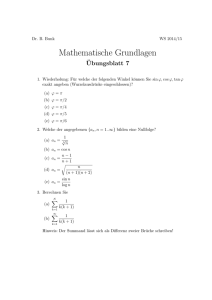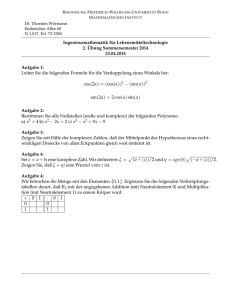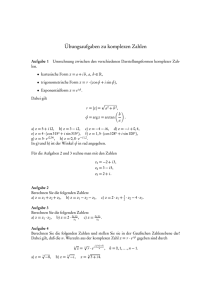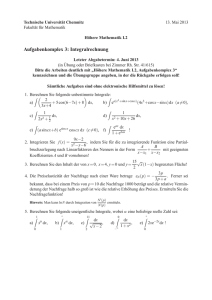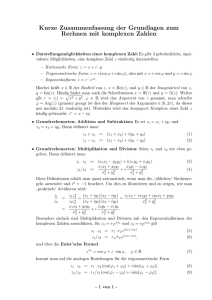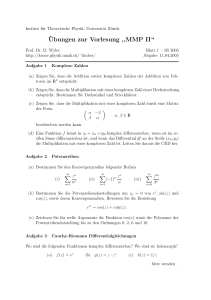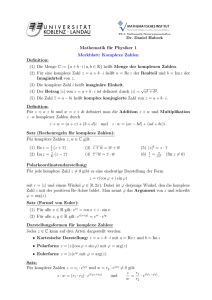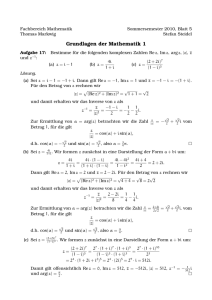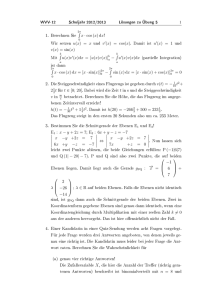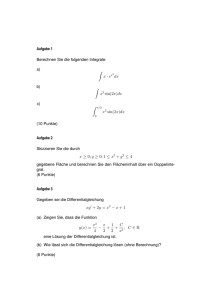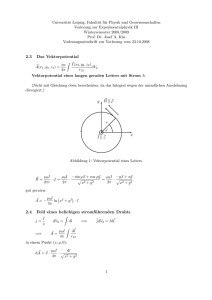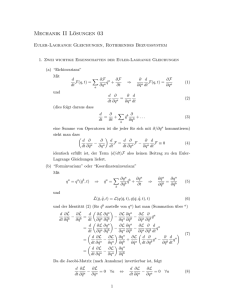1 Die komplexen Zahlen C
Werbung
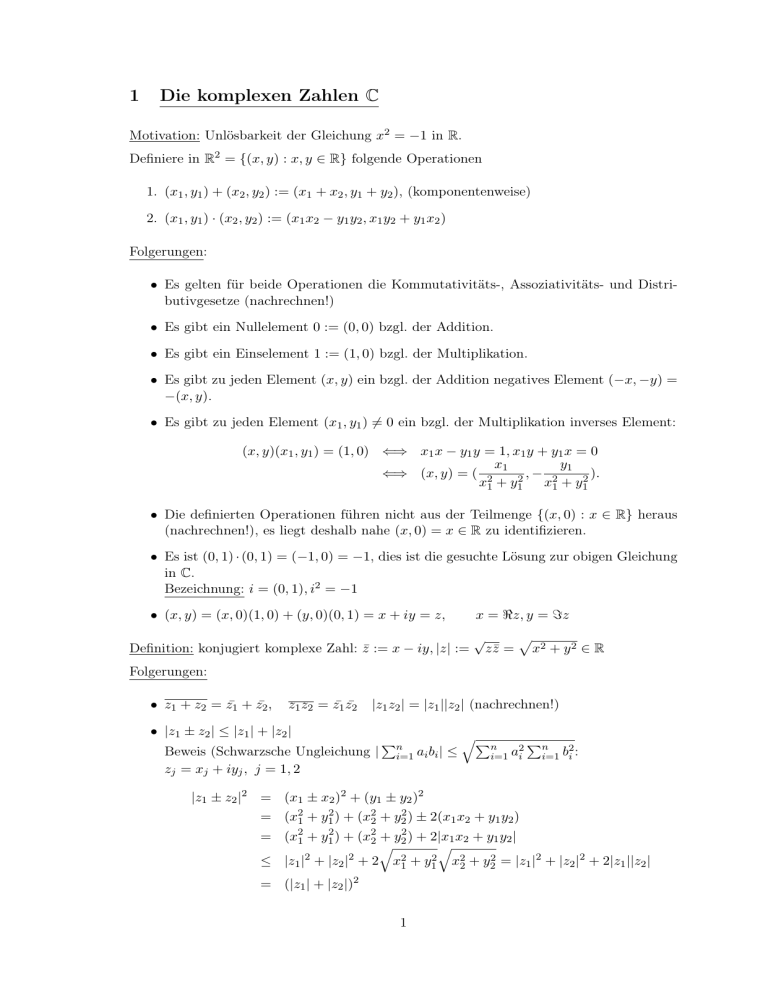
1
Die komplexen Zahlen C
Motivation: Unlösbarkeit der Gleichung x2 = −1 in R.
Definiere in R2 = {(x, y) : x, y ∈ R} folgende Operationen
1. (x1 , y1 ) + (x2 , y2 ) := (x1 + x2 , y1 + y2 ), (komponentenweise)
2. (x1 , y1 ) · (x2 , y2 ) := (x1 x2 − y1 y2 , x1 y2 + y1 x2 )
Folgerungen:
• Es gelten für beide Operationen die Kommutativitäts-, Assoziativitäts- und Distributivgesetze (nachrechnen!)
• Es gibt ein Nullelement 0 := (0, 0) bzgl. der Addition.
• Es gibt ein Einselement 1 := (1, 0) bzgl. der Multiplikation.
• Es gibt zu jeden Element (x, y) ein bzgl. der Addition negatives Element (−x, −y) =
−(x, y).
• Es gibt zu jeden Element (x1 , y1 ) 6= 0 ein bzgl. der Multiplikation inverses Element:
(x, y)(x1 , y1 ) = (1, 0) ⇐⇒ x1 x − y1 y = 1, x1 y + y1 x = 0
x1
y1
⇐⇒ (x, y) = ( 2
,−
).
x1 + y12 x21 + y12
• Die definierten Operationen führen nicht aus der Teilmenge {(x, 0) : x ∈ R} heraus
(nachrechnen!), es liegt deshalb nahe (x, 0) = x ∈ R zu identifizieren.
• Es ist (0, 1) · (0, 1) = (−1, 0) = −1, dies ist die gesuchte Lösung zur obigen Gleichung
in C.
Bezeichnung: i = (0, 1), i2 = −1
• (x, y) = (x, 0)(1, 0) + (y, 0)(0, 1) = x + iy = z,
x = <z, y = =z
Definition: konjugiert komplexe Zahl: z̄ := x − iy, |z| :=
√
z z̄ =
p
x2 + y 2 ∈ R
Folgerungen:
• z1 + z2 = z¯1 + z¯2 ,
z1 z2 = z¯1 z¯2
|z1 z2 | = |z1 ||z2 | (nachrechnen!)
• |z1 ± z2 | ≤ |z1 | + |z2 |
Beweis (Schwarzsche Ungleichung |
zj = xj + iyj , j = 1, 2
Pn
i=1 ai bi |
≤
qP
Pn 2
n
2
i=1 ai
i=1 bi :
|z1 ± z2 |2 = (x1 ± x2 )2 + (y1 ± y2 )2
= (x21 + y12 ) + (x22 + y22 ) ± 2(x1 x2 + y1 y2 )
= (x21 + y12 ) + (x22 + y22 ) + 2|x1 x2 + y1 y2 |
q
q
2
2
2
2
≤ |z1 | + |z2 | + 2 x1 + y1 x22 + y22 = |z1 |2 + |z2 |2 + 2|z1 ||z2 |
= (|z1 | + |z2 |)2
1
• ||z1 | − |z2 || ≤ |z1 ± z2 |, wegen |z1 | = |(z1 − z2 ) + z2 | ≤ |z1 − z2 | + |z2 |
• Die Zahl |z1 − z2 | ist der Abstand von z1 und z2 .
• Für δ ∈ R, δ > 0 ist Uδ (z0 ) := {z ∈ C : |z − z0 | < δ} die offene Kreisscheibe vom
Radius δ um z0 .
Trigonometrische Darstellung (Polarkoordinaten):
z = x + iy; r = |z| =
p
x2 + y 2 ; x = r cos ϕ; y = r sin ϕ; ⇒ z = r(cos ϕ + i sin ϕ)
z1 z2 = r1 (cos ϕ1 + i sin ϕ1 ) · r2 (cos ϕ2 + i sin ϕ2 )
= r1 r2 [(cos ϕ1 cos ϕ2 − sin ϕ1 sin ϕ2 ) + i(cos ϕ1 sin ϕ2 + sin ϕ1 cos ϕ2 )]
= r1 r2 (cos(ϕ1 + ϕ2 ) + i sin(ϕ1 + ϕ2 )),
d. h. Multiplikation der Beträge, Addition der Winkel.
2
